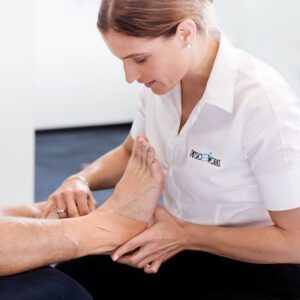Weightlifting Injuries
Article by John Miller

Weightlifting Injuries
Common Weightlifting Injuries
Weightlifting remains a popular exercise choice because it enhances strength, muscle growth, and overall fitness. However, engaging in any physical activity carries the risk of injuries. To ensure the safety of individuals and optimise their workout potential, individuals must comprehend common weightlifting injuries and actively implement suitable preventive measures.
Sprains and Strains
Sprains and strains rank among the most prevalent weightlifting injuries, occurring when ligaments or muscles are stretched or torn. Commonly affected areas include the shoulders, knees, wrists, and lower back. These injuries are often the result of poor technique, insufficient warm-up, and attempting to lift weights beyond one’s capacity. Reducing the risk of sprains and strains entails proper warm-up, gradual progression, and maintaining correct form during exercises.
Rotator Cuff Injuries
The shoulder joint’s stability relies on the rotator cuff, a group of muscles and tendons. Weightlifting exercises involving overhead movements, such as shoulder presses or snatches, can lead to rotator cuff injuries. These injuries manifest as pain, weakness, and restricted range of motion. Preventing such injuries necessitates engaging in exercises that strengthen the rotator cuff muscles and ensuring proper technique and shoulder stability during lifts.
Lower Back Pain
Weightlifting significantly affects the lower back, rendering it vulnerable to injuries like muscle strains, herniated discs, or sciatica. Poor lifting technique, inadequate core strength, and excessive weight contribute to lower back pain. Avoiding such injuries involves maintaining a neutral spine, engaging the core muscles, and gradually increasing intensity and weight. Additionally, incorporating exercises targeting the lower back and core muscles fortifies strength and stability.

Knee Injuries
Squats, lunges, and leg presses are common weightlifting exercises that engage the knees. Overloading the knees, improper form, or inadequate warm-up can result in injuries such as patellar tendinopathy, meniscus tears, or ligament sprains. Minimising the risk of knee injuries necessitates maintaining proper alignment, avoiding excessive forward knee movement, and implementing appropriate warm-up routines and gradual progression. Strengthening the surrounding muscles, such as the quadriceps and hamstrings, provides added protection.
Elbow Tendinopathy
Elbow tendinopathy, commonly referred to as “tennis elbow” or “golfer’s elbow,” refers to injury of the tendons in the elbow joint. Weightlifting exercises involving repetitive gripping or lifting motions strain the tendons and contribute to this condition. Preventing elbow tendinopathy involves employing proper grip technique, using suitable equipment, and avoiding excessive repetitions. Furthermore, incorporating exercises that strengthen the forearm muscles and allow for sufficient rest and recovery between workouts minimises the risk.
Conclusion
While weightlifting offers numerous benefits for strength and fitness, it is vital to acknowledge the potential risks and adopt necessary precautions. Individuals can significantly reduce the likelihood of common weightlifting injuries by practising proper form, gradually increasing intensity, incorporating adequate warm-up and cooldown routines, and attentively listening to one’s body.
Remember to seek guidance from a qualified trainer and consult a healthcare professional in case of persistent pain or discomfort to prioritise overall well-being.
Rochedale - Call 38410277
Book Online: RochedaleSalisbury - Call 32751044
Book Online: SalisburySandgate - Call 32691122
Book Online: SandgateArticle by Zoe Russell
Sports Physiotherapy FAQs


Sports Physiotherapy is the specialised branch of physiotherapy which deals with injuries and issues related to spokespeople. Practitioners with additional formal training within Australia are Sports & Exercise Physiotherapists.
What is Sports Physiotherapy?
Sports injuries do differ from common everyday injuries. Athletes usually require high-level performance and demands placed upon their bodies, which stresses their muscles, joints and bones to the limit. Sports physiotherapists help athletes recover from sporting injuries and provide education and resources to prevent problems. Each sports physiotherapist usually has sport-specific knowledge that addresses acute, chronic and overuse injuries. Their services are generally available to sportsmen and women of all ages engaged in sports at any level of competition.
Members of Sports Physiotherapy Australia (SPA) have experience and knowledge of the latest evidence-based practice, professional assessment and diagnosis of sports injuries, and effective hands-on management techniques and exercise protocols to assist recovery and prevent future damage. SPA members have access to the most recent advances in sports physiotherapy. You'll be pleased to know that most PhysioWorks physiotherapists and massage therapists are particularly interested in sports injury management.
General Sports Physio FAQs
- Sports Physiotherapy
- Acute Sports Injury Clinics
- Sports Physiotherapy Treatment
- Youth Sports Injuries
Injury Management
- Sports Injury? What to do? When?
- When Can You Back to Sport?
- Sports-Related Injuries
- Knee Sports Injuries
- Sports Health Conditions
Sports Massage
Sports Insurance
Related Articles
- Sports Injury Management: This article provides a comprehensive look at how sports injuries are managed, including prevention strategies and treatment options.
- Soft Tissue Injury Healing: Readers can learn about the healing process for soft tissue injuries, including practical advice for each phase of recovery.
- Prehabilitation: Key to Injury-Free Sports Performance: Offers insights into how athletes can prevent injuries before they occur, focusing on strengthening and conditioning practices.
- Athletics Injuries - Comprehensive Physio Guide: A detailed guide on common injuries in athletics and how to treat and prevent them, making it a valuable resource for athletes of all levels.
- Acute Sports Injury Clinic: Highlights the services offered by sports injury clinics, including fast-track assessments and treatments for acute sports injuries.
- Effective Management of Kids Sports Injuries: This guide focuses on the unique aspects of managing sports injuries in children, offering parents and coaches valuable advice on care and prevention.
More Information
Rochedale - Call 38410277
Book Online: RochedaleSalisbury - Call 32751044
Book Online: SalisburySandgate - Call 32691122
Book Online: SandgateCommon Muscle Injuries
A Physiotherapist's Guide
Introduction
Muscle injuries, presenting as muscle strain, pain or myalgia, are prevalent health issues affecting a wide range of individuals. This detailed guide, from a physiotherapist's perspective, delves into various muscle injuries, elaborating on their management, prevention, and the importance of professional advice. Explore the linked articles for an in-depth understanding of muscle injuries and their effective treatment.
Neck & Back Muscle Injuries: Causes and Solutions
- Back Muscle Pain: This pain often results from prolonged poor posture or physical overuse. Key to relief is engaging in exercises that strengthen the core muscles and improve posture, thereby alleviating the strain on the back.
- Neck Sprain: Caused by sudden, awkward movements, a neck sprain can benefit from a combination of gentle stretches and targeted strengthening exercises to restore flexibility and strength.
- Text Neck: A modern ailment resulting from extended mobile device use, text neck can lead to chronic pain. Regular breaks, posture-awareness, and neck-strengthening exercises are essential for prevention.
- Whiplash: Commonly occurring in car accidents, whiplash requires a careful approach including neck stabilisation exercises and controlled movement to encourage healing and prevent further injury.
Lower Limb Muscle Injuries: Understanding and Treating
- Hamstring Strain: Particularly common among athletes, particularly runners, this strain demands rest initially, followed by a carefully structured rehabilitation program focusing on gradual strength building and flexibility.
- Thigh Strain: Often seen in sports involving sprinting and jumping, thigh strains need a combination of rest, ice, compression, and elevation (RICE) in the initial stages, followed by carefully planned strengthening exercises.
- Groin Strain: This injury requires a nuanced approach, including sufficient rest and targeted exercises, to ensure a safe and effective recovery.
- Calf Muscle Tear: Key to recovery is a balance of rest, gentle stretching exercises, and a gradual return to full activity, ensuring the muscle heals correctly and strength is regained.
Upper Limb Muscle Injuries: Prevention and Care
- Golfer's Elbow and Tennis Elbow: Both these conditions involve inflammation of the tendons and require a rest period, followed by ice therapy and specific exercises tailored to strengthen the affected muscles.
- Corked Thigh: Resulting from direct impacts, these injuries demand immediate application of ice and a controlled, gradual exercise regime for recovery.
- DOMS, Fatigue-Related Cramps & Myalgia: Adequate rest, good hydration, and gentle stretching are crucial in alleviating these conditions.
- RSI: Regular stretching, ergonomic workplace adjustments, and taking breaks are key preventive measures for repetitive strain injury.
Systemic Causes of Muscle Pain: A Holistic View
- Fibromyalgia: This complex condition demands a holistic treatment approach, including exercise routines, stress management techniques, and sometimes medication.
- Rheumatoid Arthritis: Effective management combines medication, gentle exercise, and regular physiotherapy sessions.
Prevention and Management Strategies
- Regular Exercise: Regular physical activity helps maintain muscle strength and flexibility, reducing the risk of muscle injuries.
- Posture Improvement: Good posture, both in motion and at rest, is crucial for preventing muscle strain.
- Proper Warm-up and Cool-down: Adequate warm-up before and cool-down after physical activity is vital in preventing muscle strains and injuries.
- Ergonomic Adjustments: Making ergonomic adjustments at work and during daily activities can significantly reduce the risk of repetitive strain injuries and other muscle-related issues.
- Maintaining a Healthy Weight: Keeping a healthy weight reduces the strain on muscles, particularly in weight-bearing joints.
What to Do? Seeking Professional Advice
Consult a physiotherapist or doctor for personalised advice and treatment plans. Remember, early intervention can significantly improve recovery outcomes and prevent chronic problems.
Conclusion
While muscle injuries are common, effective management and prevention are achievable with the right approach and knowledge. Understanding the causes, symptoms, and various treatments available empowers individuals to take proactive steps in their recovery and prevention. For the most tailored and effective treatment, always seek the guidance of a professional physiotherapist.












































































